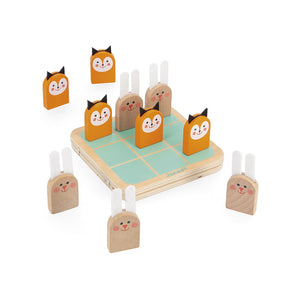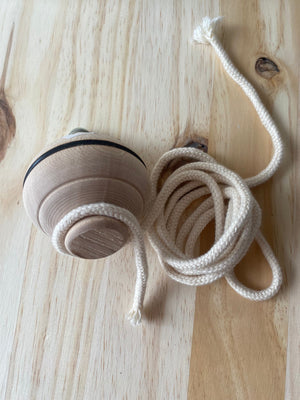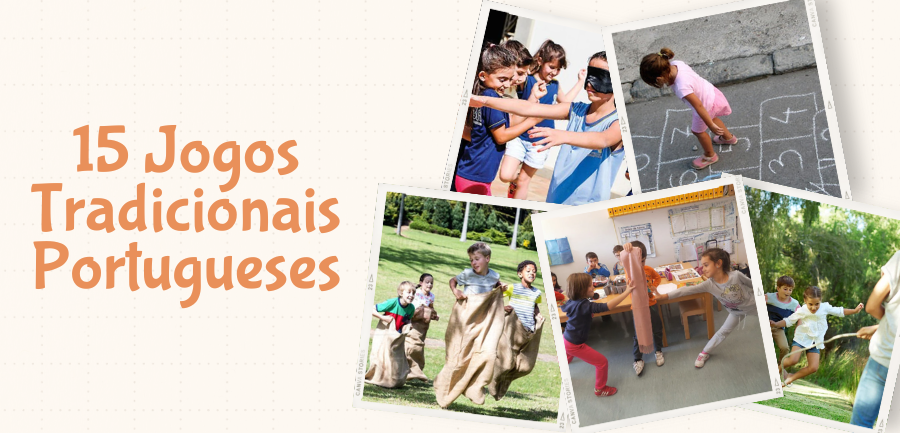Rediscover the Magic of Traditional Portuguese Games!
Spending quality time with their children is one of parents' greatest desires, but busy schedules don't always allow for it. However, being present and, especially, playing with them, enriches everyone's lives and creates lasting bonds. Reminiscing and sharing traditional Portuguese games is a fantastic way to do this, passing on culture and fun from generation to generation.
These activities, often simple and affordable, can be enjoyed anywhere, guaranteeing moments of pure joy and togetherness. We've put together a list of our favorite suggestions for family fun and unforgettable memories.
1. Blind Man's Bluff 🙈
|
👥 Number of Players: 3 or more |
📍 Location: Large and safe space (indoor or outdoor) |
|
🎲 Type: Chase / Sensory |
📝 Material: A scarf or blindfold |
How to Play:
- The playing field is defined.
- One player is chosen to be the "blind goat", who will be blindfolded.
- The blindfolded player tries to catch one of the other participants.
- After catching someone, you have to guess who it is, just by touch. If you guess correctly, you switch roles.
2. Hopscotch 👟
|
👥 Number of Players: 1 or more |
📍 Location: Outdoors (smooth floor) |
|
🎲 Type: Balance / Skill |
📝 Material: Chalk and a small stone per player |
How to Play:
- Draw the monkey on the floor (numbered 1 to 10, with "Heaven" at the end).
- The first player throws the stone to square 1.
- Hop on your heels to the square where the stone is, pick it up without stepping on the lines, and return to the beginning.
- Repeat the process for the following spaces. In double spaces, you can put both feet in.
3. Sack Race 🏃♀️
|
👥 Number of Players: 2 or more |
📍 Location: Outdoors (grass or sand) |
|
🎲 Type: Race / Competition |
📝 Material: Large bags (one per player) |
How to Play:
- Each child enters a bag up to their waist.
- They line up at the starting line and, at the signal, jump towards the finish line.
- Whoever falls, starts again from the place where they fell.
- Whoever crosses the finish line first wins. IMPORTANT: Play on a safe surface!
4. Hide and Seek 👀
|
👥 Number of Players: 3 or more |
📍 Location: Space with hiding places (indoor or outdoor) |
|
🎲 Type: Strategy / Pursuit |
📝 Material: None |
How to Play:
- A player counts to an agreed number on a "base", with his eyes closed.
- The others hide. When the count is finished, the counter looks for the others.
- The first one found is the next one to count.
- If a hidden player manages to reach the base and says "Saved everyone!", the same player counts again.
5. Ring Game 💍
|
👥 Number of Players: 5 or more |
📍 Location: Indoor / Seated |
|
🎲 Type: Attention / Bluff |
📝 Material: A ring or coin |
How to Play:
- One player "passes the ring." The others sit with their hands cupped.
- The ring passer hides the ring in his hands and passes it between the hands of each participant, letting it fall discreetly.
- Then, choose a participant to guess who has the ring.
- If you get it right, it's your turn to pass the ring. If you get it wrong, you're eliminated or given a prize.
6. Handkerchief Game
|
👥 Number of Players: 6 or more |
📍 Location: Wide Space |
|
🎲 Type: Racing / Attention |
📝 Material: A scarf |
How to Play (Team Version):
- Two teams are created, and each player has a corresponding number on the opposing team.
- A "judge" in the center holds the handkerchief and calls out a number.
- Players with that number race to collect the handkerchief and return to base without being touched.
- If you succeed, your team scores a point. If you're touched, the opposing team scores a point.
7. Marbles Game 🔵
|
👥 Number of Players: 2 or more |
📍 Location: Dirt or smooth ground |
|
🎲 Type: Aiming / Strategy |
📝 Material: Marbles and chalk |
How to Play:
- Draw a circle on the floor and place some marbles in the center.
- In turn, each player throws their "smothering" marble from outside the circle.
- The objective is to push the marbles out of the circle to win them.
- Whoever has the most marbles at the end wins.
🛒 Guaranteed fun!
Marbles are a classic that never goes out of style. Check our store to see if we have anything new for you!
8. Cat and Mouse Game 🐈⬛🐀
|
👥 Number of Players: 8 or more |
📍 Location: Wide Space |
|
🎲 Type: Pursuit / Cooperation |
📝 Material: None |
How to Play:
- A "cat" and a "mouse" are chosen. The remaining players form a circle holding hands.
- The mouse stays inside the circle and the cat outside.
- The children in the circle help the mouse escape (by raising their arms) and make it difficult for the cat to enter (by lowering their arms).
- The cat's goal is to catch the mouse. When it does, new players are chosen.
9. Tic Tac Toe #️⃣
|
👥 Number of Players: 2 |
📍 Location: Anywhere |
|
🎲 Type: Strategy |
📝 Material: Paper and pen (or chalk) |
How to Play:
- A 3x3 grid is drawn. One player plays with "X" and the other with "O".
- In turn, each player marks an empty space.
- The objective is to get three of your symbols in a line (horizontal, vertical or diagonal).
10. Spinning Top Game 💫
|
👥 Number of Players: 1 or more |
📍 Location: Smooth floor |
|
🎲 Type: Skill / Dexterity |
📝 Material: Spinning top and string |
How to Play:
- The string is wrapped around the top.
- Launch with a quick flick of the wrist, pulling the string to spin it around.
- You can play to see who can spin it the longest or to hit other tops.
11. Chinese Monkey Game 🐒
|
👥 Number of Players: 3 or more |
📍 Location: Wide Space |
|
🎲 Type: Speed / Attention |
📝 Material: None |
How to Play:
- One player (the "monkey") stands with his back to the others next to a wall.
- As he says "One, two, three, little Chinese monkey!", the others advance.
- When the "monkey" turns around, everyone must remain still. Whoever moves goes back to the beginning.
- Whoever manages to touch the wall first wins.
12. Jump Rope 🤸
|
👥 Number of Players: 1 or more |
📍 Location: Wide Space |
|
🎲 Type: Physical / Rhythm |
📝 Material: Jump rope |
How to Play:
-
Individual: A child jumps, trying to keep the rhythm as long as possible.
-
In a group: Two children swing a long rope while the others try to jump, one at a time or together, often singing songs.
🛒 Do you need a rope?
We have fun options for all ages!

13. Musical Chairs 🎶🪑
|
👥 Number of Players: 4 or more |
📍 Location: Wide Space |
|
🎲 Type: Speed / Attention |
📝 Material: Chairs and music |
How to Play:
- Chairs are placed in a circle, with one less than the number of participants.
- Players dance around the chairs as the music plays.
- When the music stops, everyone tries to sit down. Whoever is left without a chair is eliminated.
- A chair is removed and the game continues until there is only one winner left.
14. Human Rope 🔗
|
👥 Number of Players: 6 or more |
📍 Location: Wide Space |
|
🎲 Type: Pursuit / Cooperation |
📝 Material: None |
How to Play:
- An initial "catcher" is chosen. The others flee in a defined area.
- When the catcher touches someone, that player joins hands with him, forming a chain.
- Only players at the ends of the chain can catch. The chain cannot be broken.
- The game continues until everyone is caught.
15. Egg and Spoon Race 🥚🥄
|
👥 Number of Players: 2 or more |
📍 Location: Outdoors |
|
🎲 Type: Balance / Competition |
📝 Material: Eggs and spoons |
How to Play:
- Each player balances an egg on a spoon (held with their hand or mouth).
- At the signal, they run to the finish line.
- If the egg falls, the player must stop, pick it up, and start again from where it fell.
- Whoever gets there first with the egg on the spoon wins.
Other Popular Games and Play 🎲
-
Petanque: A classic aiming game , ideal for playing outdoors. (If you're looking for alternatives, check out our outdoor games !)
-
Broken Telephone Game: A game of whispering a message into someone's ear, which guarantees lots of laughs with the distortions that arise.
-
Classic board games: Checkers, Chess, Ludo... are always a great option. Explore our selection of board games .
The important thing is to have fun together!
These are just a few examples. The most important thing is to adapt the rules to the age and group, ensure safety, and, of course, create unforgettable memories!
Explore our Gotu online store for more ideas and toys!
Visit Gotu Store 😊





























